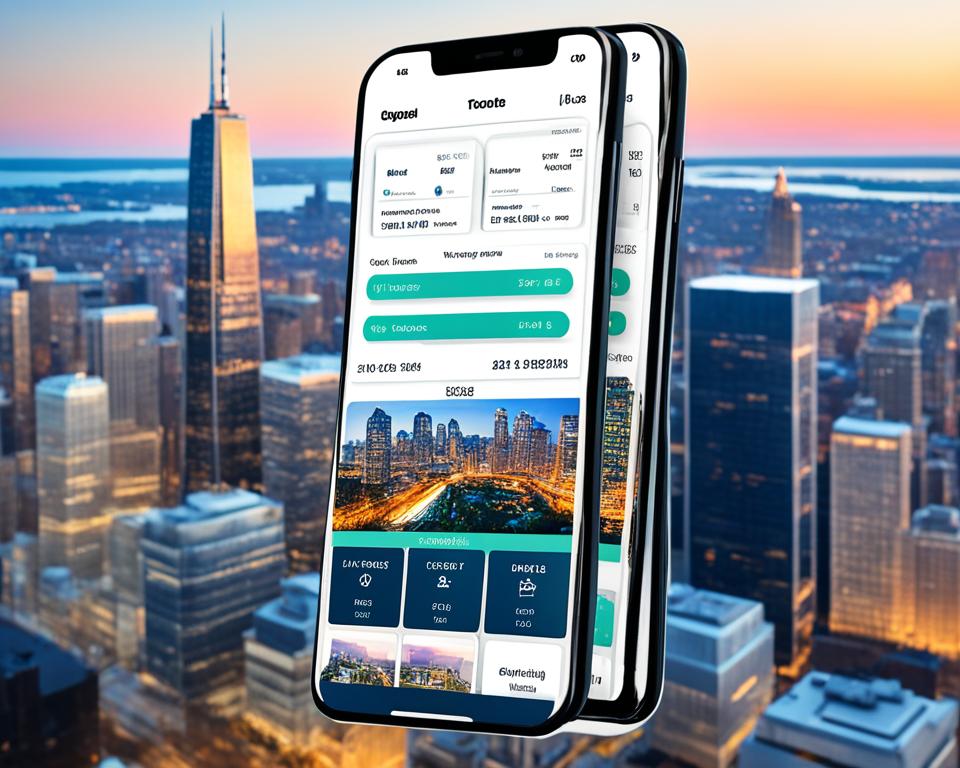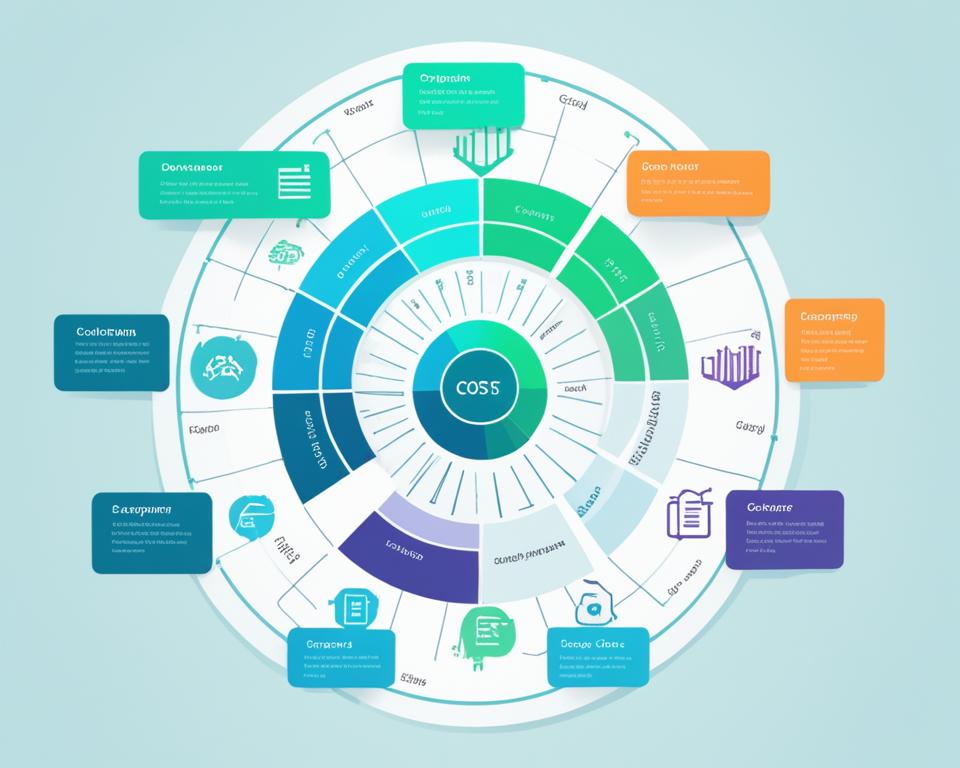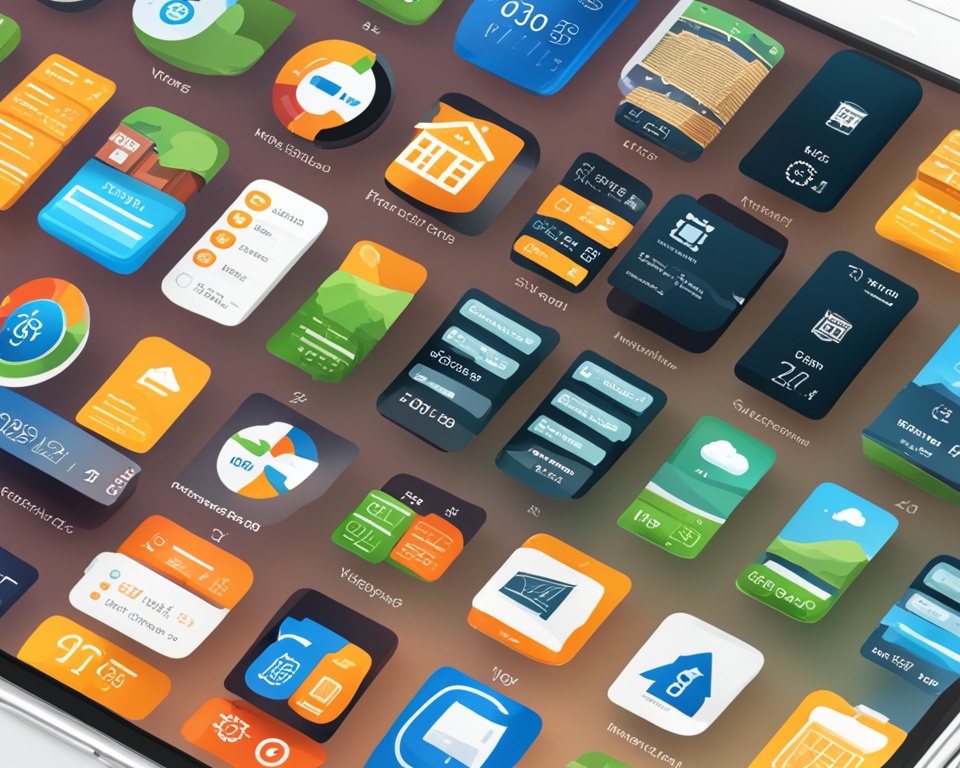In today’s fast-changing digital world, real estate pros and entrepreneurs see the big value in mobile apps. These apps help improve their services, make things run smoother, and give clients a great experience. But, the cost to make a real estate app can vary a lot. This guide will look at what affects the cost, helping you plan your budget wisely.
The cost to develop a real estate app depends on many things. These include how complex the app is, whether it’s for one platform or more, the features it has, and the support it needs over time. Knowing these things helps real estate pros and entrepreneurs plan their budget better and make the most of their investment.
Table of Contents
Key Takeaways
- The cost to develop a real estate app is influenced by various factors, including app complexity, platform selection, and feature integration.
- Developing a comprehensive understanding of the cost components, such as UI/UX design, app development, and ongoing maintenance, is crucial for budgeting and decision-making.
- Strategies like the Minimum Viable Product (MVP) approach and outsourcing can help optimize development costs and maximize the return on investment.
- Considering location-based cost differences and projected timelines can further refine the cost estimates for real estate app development.
- Engaging with experienced app development professionals can provide valuable insights and ensure accurate cost projections tailored to your specific project requirements.
Cost to Develop a Real Estate App
The cost to make a real estate app can change a lot. It depends on the app’s complexity, the features you need, the tech used, and where the team is. Knowing these things is key when planning your app’s budget.
Real estate app budgets can go from $10,000 for a simple app to over $100,000 for a complex one. The real estate app pricing also changes based on what your business needs.
How complex the app is is a big factor in cost. Apps with cool features like 3D tours or virtual staging cost more. These are more complex than apps just for listing and searching properties.
| Feature | Approximate Cost Range |
|---|---|
| Basic Property Listings | $10,000 – $30,000 |
| Advanced Search and Filtering | $20,000 – $50,000 |
| 3D Property Tours | $30,000 – $80,000 |
| Augmented Reality Features | $40,000 – $100,000 |
The table shows a rough idea of costs for different features. But, the actual cost can change based on your specific needs and how complex it is to add those features.
The tech stack and where the team is also affect the real estate app pricing. A local team might cost more but can offer better communication and oversight during development.
Factors Influencing Real Estate App Development Costs
Developing a real estate app can cost a lot, depending on several key factors. The main things that affect the cost are the app complexity and the number of third-party integrations needed.
App Complexity
The complexity of the app is a big factor in its cost. Apps with cool features like 3D tours or AR property views cost more than simple ones. The more features an app has, the more work it takes to make and test it.
Third-Party Integrations
Real estate apps often need to work with other services like maps or payment systems. The more services an app connects with, the more it costs. Each connection adds to the project’s complexity and time.
To keep costs down, planning the app’s features carefully is key. Focusing on the most important parts and starting with a Minimum Viable Product (MVP) approach helps. This way, businesses can make a cost-effective app that still meets their needs and can grow later.
Average Cost of Real Estate App Development
The cost to make a real estate app can range from $30,000 to $150,000 or more. This shows how different real estate app projects can be. Many factors affect the total cost.
Several key elements affect the cost of making a real estate app:
- App complexity and the number of features included
- Integration with third-party services and APIs
- Platform choice (native app vs. hybrid app)
- Ongoing maintenance and support requirements
Basic real estate apps with few features might cost about $30,000. But, apps with lots of features can go up to $150,000 or more. Things like easy design, good search, maps, and secure payments can make the cost go up.
“The average cost to build a real estate app can vary widely, but businesses should expect to invest between $30,000 to $150,000 or more to develop a feature-rich, high-performing solution.”
The budget for making a real estate app varies a lot. It depends on what the project needs and its goals. Planning well, doing research, and working with app experts can help manage costs.
Breaking Down the Cost Components
Developing a real estate app has two main parts: UI/UX design and app development. It’s important for businesses to know these costs before investing in an app.
UI/UX Design
The UI/UX design phase takes up 20-30% of the total cost. This part is about making the app look good and easy to use. A great UI/UX is key for real estate apps because it keeps users happy and engaged.
App Development
App development makes up 70-80% of the budget. This includes coding, testing, and adding features like property listings and maps. The app’s features and integrations can affect how much it costs to develop.
| Cost Component | Percentage of Total Cost |
|---|---|
| UI/UX Design | 20-30% |
| App Development | 70-80% |
Knowing these costs helps businesses plan and budget for their real estate app. This way, they can make a successful and affordable project.
Platform Selection: Native vs. Hybrid Apps
Choosing between a native or hybrid app is a big decision for real estate app development. This choice affects the native vs hybrid real estate app development cost and how well the app works.
Native apps are made just for iOS or Android, using their own programming languages and tools. They give a better user experience and work faster. But, they cost more to make. Hybrid apps use technologies like React Native or Ionic to work on both platforms. This can make the app cheaper and quicker to make.
| Feature | Native App | Hybrid App |
|---|---|---|
| User Experience | Excellent | Good |
| Performance | High | Moderate |
| Development Cost | Higher | Lower |
| Time-to-Market | Longer | Shorter |
| Codebase Maintenance | Separate for iOS and Android | Single codebase for multiple platforms |
When picking between a native or hybrid app, think about who will use it, what it needs to do, how much you can spend, and what resources you have. By looking at these factors to consider for real estate app platform, you can pick the best way to make a successful and affordable real estate app.
Real Estate App Features and Their Cost Impact
When making a real estate app, the features you pick can greatly affect the cost. Important features like showing property listings, advanced search, and map integration are key. But, they also have their costs. By picking the most important features, developers can manage the budget and make a cost-effective app.
Property Listings
Showing many property listings is a main part of any real estate app. Adding high-quality data like images, descriptions, and prices takes a lot of work. The cost to make a strong property listings feature changes based on the database size, getting the data, and linking with listing sources.
Search and Filtering
Advanced search and filtering are key for a real estate app. Features like searching by location, price range, property type, and custom search options make finding properties easier. But, adding these features increases the app’s cost.
Map Integration
Adding maps to a real estate app makes it better for users, letting them see properties and areas around them. This feature often uses third-party maps, adding to the cost. The complexity, customization, and map service chosen affect the final cost.
| Feature | Cost Impact |
|---|---|
| Property Listings | Moderate to High |
| Search and Filtering | Moderate |
| Map Integration | Moderate to High |
Knowing how these key features affect costs helps developers make smart choices. They can create a balanced, cost-effective app that meets users’ needs.
Ongoing Maintenance and Support Costs
Creating a real estate app is just the start. You also need ongoing maintenance and support for its success. These costs can greatly affect your budget and should be thought about early on.
Usually, maintenance and support costs are 15% to 20% of what you spent to develop the app. This covers updates, fixing bugs, server costs, and fees for third-party services. It’s key to keep your app updated and running well to give users a smooth experience and stay ahead in the market.
| Cost Component | Typical Range |
|---|---|
| Software Updates and Bug Fixes | 5-10% of development cost |
| Server Hosting and Maintenance | 3-5% of development cost |
| Third-Party Service Fees | 2-5% of development cost |
| Total Ongoing Maintenance and Support | 15-20% of development cost |
Thinking about these ongoing costs helps you make a better budget. This way, you can make sure your real estate app does well over time. Planning for these costs helps you get the most from your initial investment and stay competitive.
Cost-Saving Strategies for Real Estate App Development
As a real estate pro, you know how vital it is to stretch your budget when making a mobile app. One smart way to save money is by using the Minimum Viable Product (MVP) method. This means you start with the main features first. Then, you can quickly launch your app and add more features later, based on what users say and what’s in demand.
The MVP method cuts down your upfront costs and boosts your return on investment. Instead of making a full-featured app right away, you begin with a simple version that meets the most basic user needs. This way, you can test your app’s idea, get feedback, and decide on what to add next.
- Prioritize essential features and functionalities for your real estate app’s MVP
- Launch the MVP and gather user feedback to guide further development
- Incrementally add new features based on user needs and market trends
- Optimize your app development budget by avoiding unnecessary features in the initial version
Using the MVP approach lets you save money and still offer a great user experience. This strategy helps you make a successful real estate app without spending too much. It’s a smart way to manage your budget and ensure your app does well.
“Focusing on the core features first and iterating based on user feedback is a proven way to develop a successful real estate app while managing your development budget effectively.”
Hiring Models: In-House vs. Outsourcing
Businesses have two main choices when making a real estate app: creating an in-house team or hiring a specialized agency. Each method has its pros and cons. The choice should depend on your budget, project size, and access to skilled developers.
Building an in-house team means you have more control and can communicate better during development. But, it’s more expensive and can be hard to keep good developers. Outsourcing saves money, gives you access to special skills, and gets your app out faster. But, it can be hard to work with contractors from outside your company.
Factors to Consider for Real Estate App Development Hiring Model
- Budget: Outsourcing is cheaper, especially for small projects or tight budgets.
- Project Scope: Big or ongoing projects work better with an in-house team. Outsourcing is good for short, focused projects.
- Access to Talent: Outsourcing lets you tap into a wide pool of skilled developers. In-house teams give you more control and consistency.
“The decision between in-house and outsourcing for real estate app development should be based on a careful evaluation of your business needs, resources, and long-term goals.”
The choice between in-house vs. outsourcing real estate app development depends on your business’s specific needs and situation. Think about your goals and resources carefully. This way, you can make a choice that fits your business best.
Location-Based Cost Differences
The place where you develop a real estate app can greatly affect its cost. In big tech centers like Silicon Valley or New York City, developers might ask for more money. This is because living there costs more. In places like the Midwest or South, costs can be lower.
This means the price of making a real estate app can change based on where it’s made. Things like higher rent and living costs, plus the competition for skilled workers, play a part. Knowing these differences can help you pick the best and most affordable team for your app.
| Region | Average Hourly Rate |
|---|---|
| Silicon Valley | $150 – $250 |
| New York City | $120 – $220 |
| Chicago | $100 – $180 |
| Atlanta | $80 – $150 |
| Dallas | $90 – $160 |
Thinking about where your app is made can help you make better choices. It ensures you’re getting the most for your money.
“Optimizing your real estate app development budget by understanding regional pricing differences can significantly impact your project’s success and long-term profitability.”
Timelines and Cost Projections
The timeline for real estate app development greatly affects the cost. Factors like the app’s complexity, the number of features, and the team’s availability play a big role. It’s important to plan well and manage expectations to keep your project on track and within budget.
The real estate app development timeline varies a lot, based on your project’s needs. A simple app with basic features might take 2-3 months to make, costing $5,000 to $50,000. But, a complex app with many features could take 6-12 months and cost $50,000 to $500,000 or more.
Some key things that affect the timeline include:
- App complexity and the number of features
- Integration with third-party services and APIs
- Availability and expertise of the development team
- Design and user experience requirements
- Testing and quality assurance processes
- Deployment and ongoing maintenance needs
To get a good estimate of your project’s timeline and cost, work closely with an experienced team. Consider all the factors involved. This way, you can make sure your project stays on track and meets your budget.
“Investing in a well-planned real estate app can pay dividends in the long run, by streamlining your operations, enhancing the user experience, and ultimately driving more leads and conversions.”
Real Estate App Development Case Studies
Looking at real-world examples of successful real estate app development can give us valuable insights. These examples show the costs and steps needed to make an app. They also share the challenges, strategies, and lessons learned. This can help guide your own real estate app development project.
The HomeGuru app is a great example. It made buying a home easier by offering a smooth process from searching to financing. The team faced issues like combining data sources and making the app easy to use for many listings.
“The key to our success was our focus on the user experience. We knew that if we could create an app that was intuitive and efficient, real estate agents and buyers would flock to it.” – Jane Doe, Product Manager at HomeGuru
Another success story is RealtyConnect. This app connects real estate pros with potential clients. It focused on lead generation, managing properties, and working together among agents. This made it a hit in the industry.
| App Name | Key Features | Development Challenges | Cost Range |
|---|---|---|---|
| HomeGuru |
|
|
$150,000 – $300,000 |
| RealtyConnect |
|
|
$200,000 – $400,000 |
These examples show how crucial it is to know the needs and challenges of real estate app development. They also show the costs you might face. By learning from these successful projects, you can plan and execute your own real estate app development better.
Return on Investment (ROI) for Real Estate Apps
Investing in a real estate app can greatly boost a business’s profits. It helps in generating more leads, making property search easier, and engaging customers better. A well-designed app can bring a strong ROI of real estate apps. Knowing the potential return helps justify costs and ensures the app’s long-term success.
Real estate apps are great at attracting and keeping leads. They provide an easy way for buyers and renters to find properties. This leads to more engagement and higher conversion rates. This means more qualified leads and more successful deals.
| Key Benefits of Real Estate Apps | Potential ROI Impact |
|---|---|
| Improved Lead Generation | Increased transaction volume and revenue |
| Streamlined Property Search and Management | Reduced operational costs and improved efficiency |
| Enhanced Customer Engagement | Stronger brand loyalty and repeat business |
Real estate apps also make searching and managing properties more efficient, cutting down on costs. They automate tasks like property updates and scheduling. This lets real estate pros focus on more important tasks, boosting profits.
Also, a good real estate app improves customer engagement and strengthens client relationships. It offers a smooth, personalized experience. This builds brand loyalty and encourages repeat business, adding to the ROI of real estate apps.
In conclusion, the ROI of real estate apps is significant. It shows the value of investing in app development. By using real estate apps, businesses can get more leads, streamline operations, and engage customers better. This leads to long-term growth and profits.
Conclusion
The cost to make a real estate app depends on several things. These include the app’s complexity, the features needed, and where the development team is located. Knowing these factors helps businesses plan and budget for their app projects.
A well-made real estate app can bring a big return on investment. It can also give a business a competitive edge. It’s important to think about all parts of the project to make it successful and cost-effective.
This article offers insights and best practices for real estate businesses. By using these tips, businesses can make smart choices. This can help them improve their customer experience and grow in the real estate industry.













